Top 10 Movie Props of All-Time
WhiteClouds builds 3D Large Movie Props
The Top 10 Movie Props of All-Time: Icons of Cinematic Magic
Movies are more than just a succession of images and sound; they are a complete sensory experience that often transports us into different worlds, times, and emotions. While the actors, directors, and cinematographers play critical roles in creating cinematic magic, let’s not forget the unsung heroes of filmmaking—the props. These are the physical objects that breathe life into a story, turning fantasy into almost-tangible reality.
In this article, we dive deep into the world of movie props, highlighting the top 10 movie props that have stood the test of time to become true cultural icons.
#1: The One Ring Movie Prop – “The Lord of the Rings” Series
Get ready to journey into a realm so compelling that it not only dominates the narrative arc of a cinematic trilogy but transforms an entire genre. Enter the One Ring, the central object of desire in Peter Jackson’s cinematic rendition of J.R.R. Tolkien’s magnum opus, “The Lord of the Rings.” This trilogy didn’t merely stroll down the red carpet; it blazed a trail through the Oscars, grabbing 17 Academy Awards, including back-to-back wins for Best Director and Best Picture for “The Return of the King.”

When we talk about the One Ring, we’re not just talking about a minor set piece or a transient object meant to fill the screen. We’re talking about an entity that pulls the strings of destiny, creating a world of complex heroes, corrupted souls, and everlasting legends. This Ring—conceived in Tolkien’s literary brilliance and realized in Jackson’s epic storytelling—has left an indelible mark on both cinema and the broader cultural imagination.
Why It’s Iconic: A Confluence of Simplicity, Mystique, and Universal Themes
At first glance, the One Ring appears deceptively simple—a mere circle of gold, featureless and unadorned. But don’t let its elemental design fool you. This object is the epitome of dichotomy, contrasting its visually uncomplicated form with the incredibly layered and intricate narrative it supports. Inscribed with an Elvish phrase that reads, “Ash nazg durbat ulûk, ash nazg gimbatul, ash nazg thrakatulûk agh burzum-ishi krimpatul” which translates to “One Ring to rule them all, One Ring to find them, One Ring to bring them all and in the darkness bind them,” the ring is a narrative powerhouse. Each word inscribed on its surface is like a spell, pulling us deeper into its lore and mythos.
But why is it so captivating? Why does it transcend its role as a prop to become a character in its own right? It’s because the One Ring does what only the most iconic of cinematic elements can do—it serves as a universal symbol. It doesn’t just represent power; it encapsulates the very essence of temptation, corruption, and the corrupting influence of absolute power. This is not a prop that sits idly by, as characters project their desires and ambitions onto it. Rather, it interacts with them, changes them, and even breaks them. It is the linchpin of moral dilemmas, the axis on which characters rotate and evolve. It’s a psychological mirror reflecting the depths of greed, desperation, and the manifold complexities of good and evil.
Just think about it: How many times have we seen it almost consume Frodo, the most unassuming of heroes? Or corrupt Boromir, a man of noble lineage? Or empower Gollum, a creature of tragic fall and redemption? The One Ring is not just a ring; it’s a window into the souls of those who encounter it, forcing them to grapple with their darkest impulses and noblest intentions.
In a way, the One Ring is a study in contrasts—simple yet complex, inert yet dynamic, beautiful yet perilous. It distills the enormous thematic depth of “The Lord of the Rings” into a tangible, relatable object that resonates with audiences of all ages, from all walks of life. It is the embodiment of the saying that sometimes, “even the smallest things can change the course of the future.” Truly, it’s not just a prop; it’s an everlasting symbol of cinematic and storytelling genius.
#2: The Lightsaber Movie Prop – “Star Wars” Series
Prepare to ignite your imagination! In a galaxy far, far away, George Lucas unleashed upon the world a groundbreaking masterpiece of science fiction and fantasy—the “Star Wars” series. But what would the epic space saga be without its crowning glory, its unparalleled icon: the Lightsaber? Introduced in the original 1977 film, “Star Wars: Episode IV – A New Hope,” this radiant weapon has dazzled audiences across multiple generations and made a seismic impact on global pop culture. From its inaugural appearance in the hands of Luke Skywalker to its various incarnations throughout sequels, prequels, and spin-offs, the Lightsaber isn’t just a prop; it’s a phenomenon.

This isn’t merely a sword made of light; it’s an iconic piece of film history, a revolutionary concept that blended science fiction and medieval chivalry in one electrifying package. The mere sight of a Lightsaber igniting sends shivers down the spines of fans young and old, setting the stage for epic showdowns between the forces of good and evil. Its cultural relevance is so profound that it has transcended cinema to become a staple in everything from video games to toy stores, from cosplays to philosophical debates about the nature of the Force.
Why It’s Iconic: A Multifaceted Symbol of Mythology, Philosophy, and Individual Identity
The Lightsaber is more than a prop—it’s a grand spectacle, an embodiment of age-old archetypes, and a canvas upon which the series paints its intricate moral, spiritual, and philosophical dilemmas. Imagine it: the moment a Jedi or Sith ignites that blade, a thousand stories are told. The sound—the unforgettable, electrifying hum—immediately announces the presence of a force to be reckoned with. The color—whether the virtuous blue and green of the Jedi or the menacing red of the Sith—acts as a visual shorthand for a character’s moral standing or inner struggle. The fighting style—each swing, parry, and thrust—reveals layers of personality and skill, making every duel not just a physical confrontation, but a battle of ideals, convictions, and destiny.
In the “Star Wars” universe, the Lightsaber functions almost like an extension of its wielder’s soul. It is assembled by the Jedi as a rite of passage, often involving a deeply personal quest to obtain a Kyber crystal, the beating heart of the weapon. It’s not just about plasma blades and laser technology; it’s about the metaphysical meeting the mechanical. The Lightsaber explores the delicate balance between technology and mysticism, grounding its futuristic appearance with roots that delve deep into various philosophies and mythologies—from Arthurian legends of knights and swords to Eastern philosophies about balance and duality.
What’s even more spectacular is how the Lightsaber evolves with its wielder. Whether it’s Anakin Skywalker’s descent into Darth Vader, marked by his switch from a blue to a red blade, or Rey’s construction of her own Lightsaber to signify her unique path in the Force, this is a prop that participates in character development. It’s so entwined in the storyline that it almost serves as a narrator of the characters’ inner journeys, their shifts in allegiance, and their ultimate fates.
It’s nearly impossible to separate “Star Wars” from the Lightsaber. It’s a symbol of hope, a weapon of destruction, a rite of passage, and a tool for justice—or oppression. Its complexity lies in its simplicity: a beam of light that can cut through darkness both literally and metaphorically. The Lightsaber isn’t just a movie prop; it’s an enduring cultural icon that encapsulates the dreams, fears, and aspirations of generations. It stands as an everlasting confirmqation to the limitless potential of storytelling, a symbol that wields almost as much power in our world as it does in the galaxy far, far away.
#3: The DeLorean Time Machine Movie Prop – “Back to the Future” Series
Buckle your seatbelt and hit 88 miles per hour because we’re speeding into the annals of cinematic history with one of the most iconic movie props ever devised: the DeLorean Time Machine from Robert Zemeckis’s legendary “Back to the Future” series. Debuting in the groundbreaking 1985 film, this modified DeLorean DMC-12 is far more than a mere prop—it’s a cultural icon, a mechanical muse that captivated audiences and redefined the very concept of time travel in popular culture. Could anyone have predicted that a stainless-steel sports car, equipped with a flux capacitor and fueled by a combination of plutonium and trash, would drive its way into the hearts and minds of millions? Probably not, but that’s the magic of cinema!
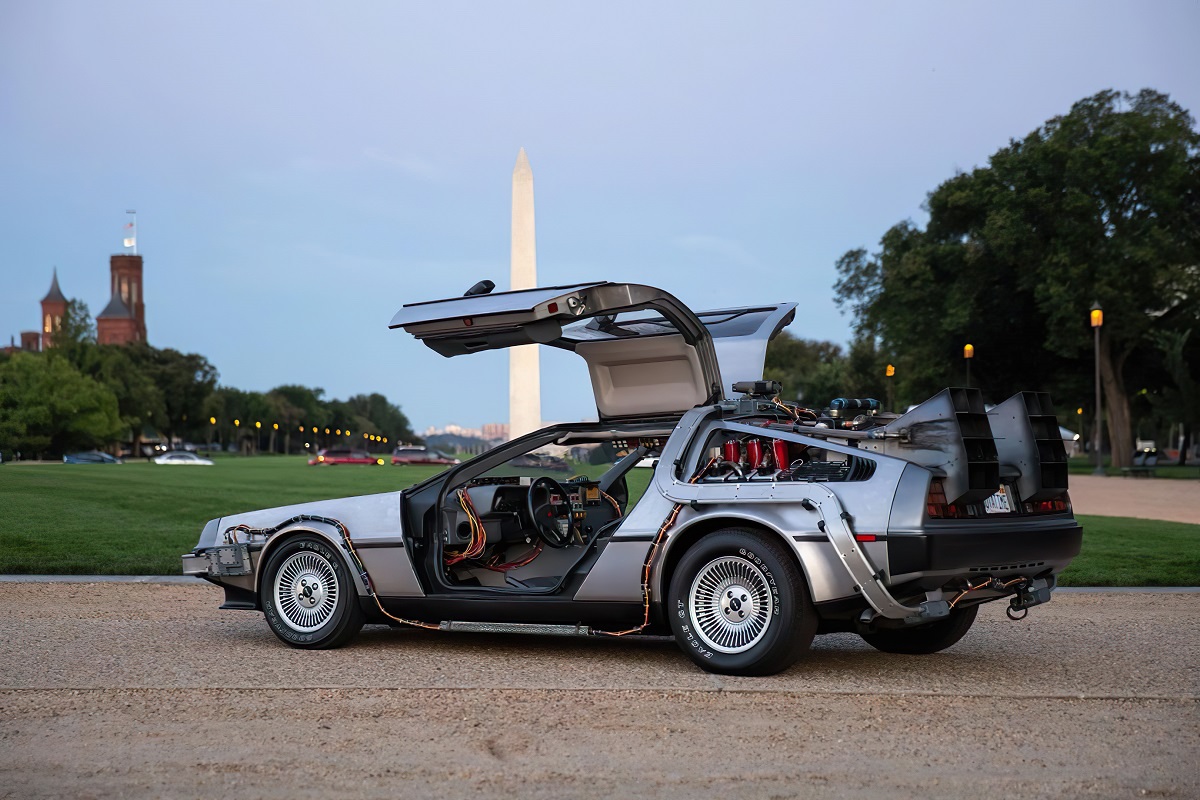
But let’s pump the brakes for a moment to understand the breathtaking ingenuity involved in conceptualizing the DeLorean Time Machine. Transforming a sleek but commercially unsuccessful car into the defining time-travel apparatus of a generation was no small feat. It was a stroke of genius, a fusion of 1980s aesthetic, scientific jargon, and sheer imaginative power. And let’s not forget, it was a vehicle that transcended its role in the narrative to become a symbol of innovation, freedom, and the boundless possibilities of the future—both in the fictional world of Hill Valley and in the real world where replicas are lovingly crafted by die-hard fans.
Why It’s Iconic: An Endearing Mix of Nostalgia, Scientific Fantasy, and Human Adventure
When Marty McFly first steps into the DeLorean, fires up the flux capacitor, and blasts back to 1955, something magical happens that extends far beyond the boundaries of the screen. In that moment, the DeLorean ceases to be just a car or even just a time machine; it becomes a vehicle of dreams, aspirations, and the inexorable human desire to rewrite our own histories or peek into the veiled realms of the future. From its unforgettable gull-wing doors to the digital time circuits and the enigmatic Mr. Fusion, every element of this machine screams innovation and excitement.
The DeLorean’s status as an iconic prop is cemented by its ability to mesh science fiction with relatable human drama. It takes the paradoxes and complexities of time travel—subjects usually reserved for theoretical physicists and science fiction enthusiasts—and presents them in a way that anyone can understand and enjoy. Want to fix a past mistake? Jump in. Want to see how your life turns out? Set the dials. It engages the audience’s imagination while also stirring emotional investment. Whether it’s Marty ensuring his parents fall in love or Doc Brown finding love in the Old West, the DeLorean is the linchpin that makes these poignant, human stories possible.
But it’s not just about the thrills and the science; it’s about the philosophy of existence. What would you do if you could travel through time? Would you tamper with events, risking the fabric of reality for personal gain? Or would you become a passive observer, respecting the timeline but forever haunted by the “what-ifs”? The DeLorean is a vehicle that challenges its occupants—and by extension, its audience—to ponder these moral and existential dilemmas. It offers the tantalizing prospect of the impossible while also serving as a cautionary tale of the potential dangers of playing God.
Over the years, the DeLorean Time Machine has solidified its status as not just a cinematic icon but as a symbol of a certain kind of American imagination—bold, audacious, a little bit reckless, but always tinged with a sense of wonder and aspiration. It epitomizes the adventurous spirit of not just the characters it transports, but the very audiences who have followed its journeys through the space-time continuum. So, the next time you see those gull-wing doors rise, and hear the whir of the flux capacitor, remember that you’re not just witnessing a movie prop—you’re seeing a piece of cultural history, an emblem of human curiosity, and a celebration of the limitless potential of storytelling. And that’s why, when it comes to iconic movie props, the DeLorean Time Machine is truly in a league of its own.
#4: The Ruby Slippers Movie Prop – “The Wizard of Oz”
Step into the enchanted world of celluloid history where the Ruby Slippers from “The Wizard of Oz” reign supreme as one of the most beguiling and poignant movie props of all time. Conjured during the Golden Age of Hollywood, these slippers didn’t just adorn the feet of Judy Garland as she portrayed the ever-adorable Dorothy; they literally and figuratively carried the entire story to its poignant crescendo. The year was 1939, a seminal period in cinematic history teeming with innovation, and these radiant slippers came to symbolize so much more than a mere costume choice—they became a universal emblem of home, nostalgia, and the ceaseless march of time.
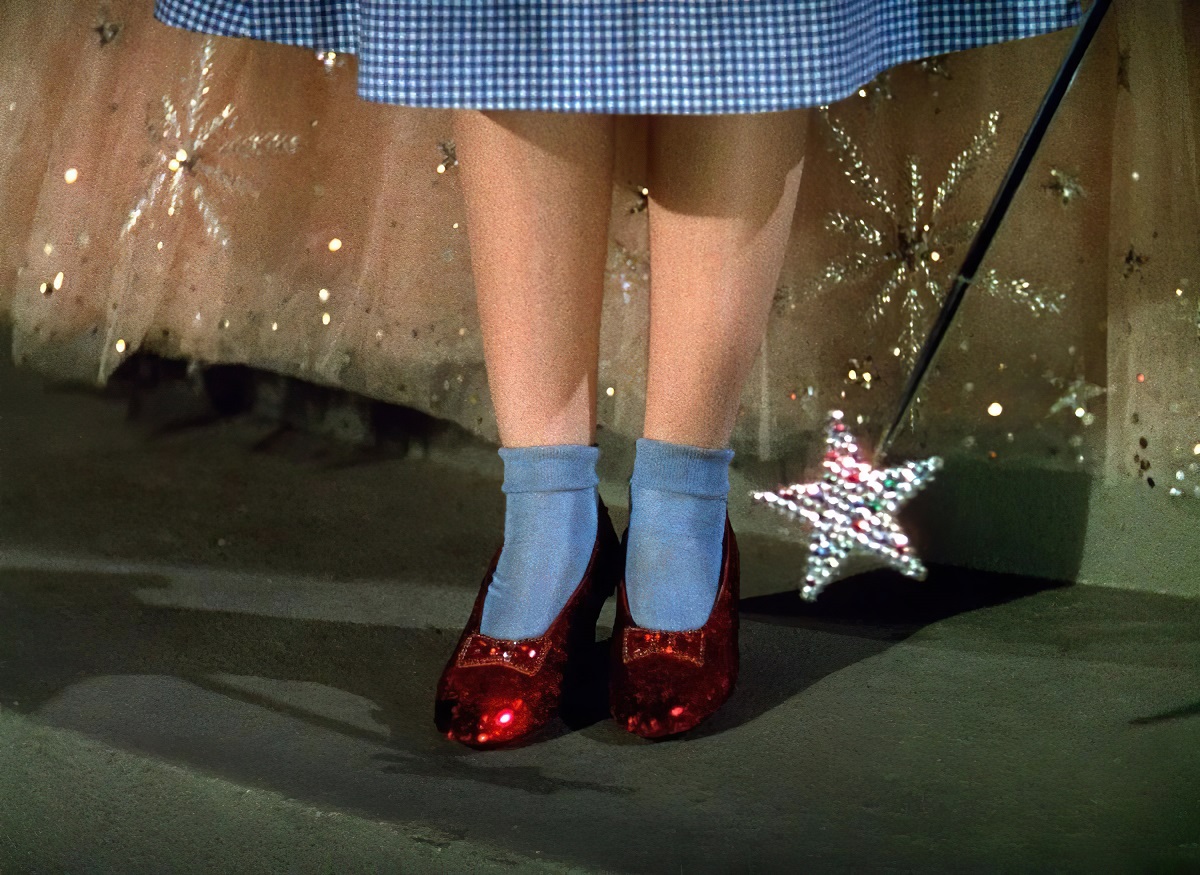
Think about it: an entire industry of visual storytelling, encapsulated in a pair of dazzling red shoes. They weren’t just a relic of their time but a vibrant, magical element that transported audiences from the black-and-white mundanity of Depression-era America into the kaleidoscopic splendor of Oz. How could anyone ever forget the moment Dorothy steps into the colorful realm of Munchkinland, with her Ruby Slippers glittering in the vivid Technicolor splendor? It’s as if the slippers themselves were narrating a tale of change, innovation, and the infinite possibilities of storytelling.
Why It’s Iconic: A Profound Symbol of Emotional and Physical Sanctuary
Ah, but let’s not get too lost in the spectacle, for the core essence of the Ruby Slippers is something far more profound and touching. These aren’t just radiant ornaments; they are philosophical artifacts that explore complex themes of home, belonging, and the emotional topographies that we navigate throughout our lives. In its most literal sense, the phrase “there’s no place like home” encapsulates the idea of home as a physical space—a sanctuary where one feels secure and loved. But peel back the layers, and you’ll find that these sparkling shoes delve deeper into the fabric of the human experience.
These slippers are magical not because they can transport Dorothy back to Kansas, but because they signify the universal longing for a place where one truly belongs—a sanctuary not just of bricks and mortar but of heart and soul. Think of the countless children and adults alike who have been enthralled by the moment when Dorothy clicks her heels together and utters those immortal words. For many, it’s a transformative cinematic experience that conveys a lifelong lesson about the real essence of home. It’s a lesson that speaks not just to the geographical or temporal concept of home, but to an emotional, even metaphysical, state of being. It’s not just about going back to where you started; it’s about understanding what “home” truly means to you.
And let’s not forget how the Ruby Slippers have permeated the very fabric of global culture. Beyond the screen, these iconic shoes have found their way into museums, inspired fashion designers, and been subject to endless homages and parodies. They’ve crossed the boundaries of film to become cultural artifacts, teaching new generations that the concept of home extends beyond four walls and a roof—it’s a deeply embedded part of our collective consciousness, an idea that transcends age, geography, and even time itself.
So, as you reflect upon the Ruby Slippers, remember that they are not merely a piece of Hollywood memorabilia or a flashy accessory for a young girl lost in a fantastical world. They are a powerful metaphor, imbued with the wisdom of ages and the sparkle of timeless storytelling. Through them, “The Wizard of Oz” tells us that no matter how far we roam or how lost we may feel, our journey isn’t complete until we find our way back to the comforts and understandings of home. These shoes don’t just shine; they illuminate the human experience, tapping into a wellspring of universal desires and eternal truths. That’s why, in the pantheon of cinematic props, the Ruby Slippers will always hold a place of enduring magic and significance.
#5: Wilson Volleyball Movie Prop – “Cast Away”
When we talk about iconic movie props, it’s often easy to be swept away by the glitz and glamor of sparkling slippers or the sci-fi allure of futuristic weapons. But what about an unadorned sports item that transformed into a lifeline for one of cinema’s most isolated characters? Enter the humble yet captivating Wilson Volleyball from Robert Zemeckis’s seminal 2000 film, “Cast Away.” Its origin is as unassuming as you can imagine—a simple volleyball plucked from the debris of a FedEx plane crash, becoming the co-star of a film that explores the depths of human isolation and the quest for survival. This transformation from an ordinary object into a symbol of companionship and sanity elevates Wilson from a simple piece of sporting equipment to a character in its own right, cementing its place in cinematic lore.

In the scope of Hollywood history, Wilson stands as an antithesis to the usual spectacle associated with blockbuster filmmaking. There are no special effects or complex choreography involved in its screen time. Its purpose in the narrative was not planned with grandeur but was conjured in the crucible of storytelling necessity and emotional resonance. The film’s success in turning an inanimate object into an emotional cornerstone for the lead character, portrayed by the formidable Tom Hanks, is a testament to the power of minimalist filmmaking and the incredible capacity of audiences to invest emotionally in the most unlikely of on-screen relationships.
Why It’s Iconic: The Volleyball That Became a Phenomenon of Emotional Storytelling
In the annals of film history, there have been plenty of props that have served functional or thematic roles, but none quite like Wilson. It begins as an ordinary object—a volleyball—but its transformation into a ‘character’ redefines how we think about storytelling elements. Wilson isn’t just a volleyball; it is an emotional vessel that captivates audiences by embodying universal themes of loneliness, companionship, and the human need for connection in extreme conditions. Its face, etched in simplicity with a bloody handprint, evokes more than just a crude visage; it encapsulates a hauntingly poignant essence of the isolation and desperation experienced by a man stranded far from civilization.
Imagine for a moment being utterly alone, stranded on a deserted island with nothing but your own ingenuity for company. In such a bleak scenario, the human mind reaches for any semblance of companionship, even if it has to be conjured from the inanimate. The very act of Tom Hanks’ character, Chuck Noland, painting a face on Wilson demonstrates the depth of human need for social interaction, imbuing the volleyball with a personality and emotional relevance that is both palpable and heartbreaking. Wilson becomes the confidant, the sounding board, and, ironically, the sanity check for a man on the brink. It shares in Chuck’s victories, offers silent companionship during his struggles, and devastatingly floats away during an escape attempt, leaving audiences as shattered as the character who loses his only friend.
Moreover, the cultural impact of Wilson extends far beyond its runtime. It has inspired countless memes, been featured in cosplay, and has even become a staple in discussions about psychological well-being and the importance of emotional outlets in times of unprecedented solitude. The sheer relatability of Wilson to any individual who has felt the pangs of loneliness gives it an everlasting appeal.
So, when we discuss iconic movie props, Wilson holds a special place—not because of any inherent complexity, but because of its sublime simplicity and emotional resonance. It reminds us that in the grand tapestry of human existence, sometimes it’s not the extraordinary but the extraordinarily simple that leaves the most indelible marks. It challenges conventional storytelling by making us deeply care about a volleyball, pushing us to reconsider what we know about loneliness, companionship, and the lengths to which the human spirit will go to find—or create—a friend. And that’s what makes Wilson, the inanimate yet intensely evocative volleyball, a truly unparalleled icon in the realm of cinematic props.
#6: Hannibal Lecter’s Mask Movie Prop – “The Silence of the Lambs”
When we speak of horror and psychological thrillers, few props loom as large as Hannibal Lecter’s mask in the groundbreaking 1991 movie “The Silence of the Lambs.” Directed by Jonathan Demme, this film has left an indelible mark on popular culture, and much of that chilling allure is intrinsically tied to this apparatus of restraint worn by Anthony Hopkins as the cunning and malevolent Dr. Hannibal Lecter. Surprisingly, the mask makes a relatively brief appearance in the film, but its visual and psychological impact is colossally disproportionate to its screen time. One could argue that the mask’s short-lived but potent presence masterfully amplifies the lingering dread it leaves in its wake.
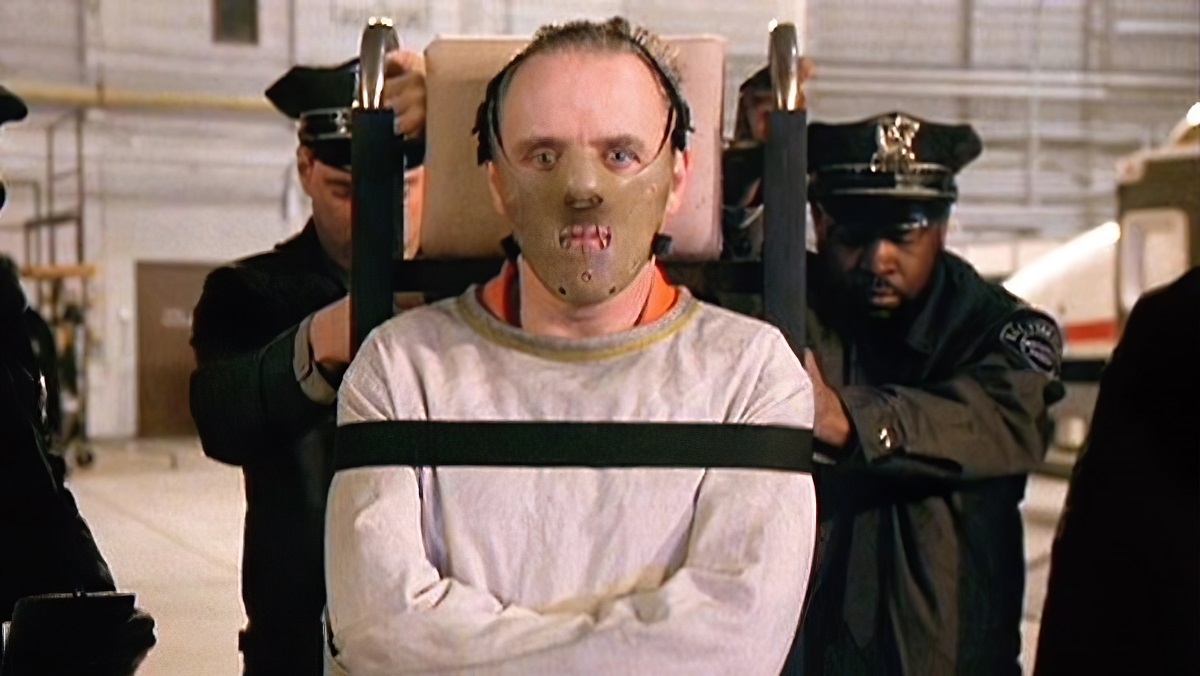
The brilliance lies not just in its stark design but in the unsettling juxtaposition it creates when worn by a man of Hopkins’ caliber. His portrayal of Hannibal Lecter is already paralyzing, but when accessorized with this horrifying piece, it transcends into the realm of nightmarish icons. The mask is simple, but its impact is labyrinthine, woven into the tapestry of a film that dissects the human psyche, societal norms, and the disturbing line that sometimes blurs the boundary between man and monster.
Why It’s Iconic: The Inescapable Dance of Savagery and Sophistication
The mask is more than just an object or a mere plot device; it is a crucible where civilization and savagery are melted down and mixed to create something both fascinating and terrifying. It is not there to protect the world from Hannibal Lecter per se but serves as a tangible, highly visual boundary that isolates the raw savagery of his actions from the disturbing sophistication of his mind. Just like a cage in a zoo allows you to observe a dangerous animal with a layer of safety, Lecter’s mask permits you to look into the eyes of evil without losing yourself completely.
But let’s dive deeper. The mask acts as a complex narrative device; it encapsulates the horrifying tension between human intellect and instinctual, predatory violence. It’s an object designed to contain the brilliant yet malevolent intellect behind it, emphasizing the paradox that exists within Hannibal Lecter and, to a certain extent, within all of us. The mask serves as an unnerving reminder that even the most cultured and intellectual among us harbor elements of primal savagery, which society and circumstance have mostly tamed but never truly eradicated. It asks us, rather directly, what facets of our own personalities are we masking to fit into the paradigms of civilization?
In a twisted way, the mask also elevates Lecter’s status. By requiring such an apparatus to contain him, the film suggests that his malevolence and intelligence are forces too formidable to be handled by traditional means. It almost becomes a crown, symbolizing his dominion in a kingdom of psychological horrors and criminal intellect. This duality makes the mask a perfect companion piece to the man wearing it, as it embodies the internal and external struggles between the human and the monstrous, the societal and the bestial.
On a broader cultural scale, Hannibal Lecter’s mask has been imprinted onto the collective psyche and has found its way into a multitude of media, from parodies to merchandise, and from Halloween costumes to academic discussions on the nature of evil. It is no longer just a movie prop but a cultural artifact that challenges our perceptions of morality, sanity, and the thin veils that separate us from our darkest selves. Its very existence pushes us to confront uncomfortable truths about the fragility of the human condition, making it an icon of restrained horror that continues to both intrigue and terrify us, long after the credits have rolled. And that, in essence, is why Hannibal Lecter’s Mask is not just a prop but a profound commentary on the complexities of human nature, making it one of the most iconic and unsettling objects in cinematic history.
#7: The Rosebud Sled Movie Prop – “Citizen Kane”
Few props have the gravitas to singlehandedly encapsulate an entire film’s thematic complexity, yet the Rosebud Sled in Orson Welles’ 1941 magnum opus, “Citizen Kane,” does exactly that. This isn’t just any toy but rather the symbolic nucleus around which the entire narrative revolves. On the surface, it’s an emblem of a childhood left far behind, but the reality is far more intricate. This seemingly innocent object is the linchpin of a story that dares to peel back the layers of a man’s life to reveal the poignant underbelly of his lost innocence and the simpler times he can never return to. As audiences are taken through a labyrinthine exploration of Charles Foster Kane’s life, ambitions, and failures, the enigmatic “Rosebud” remains an elusive promise, a riddle wrapped in the mystique of cinematic history.
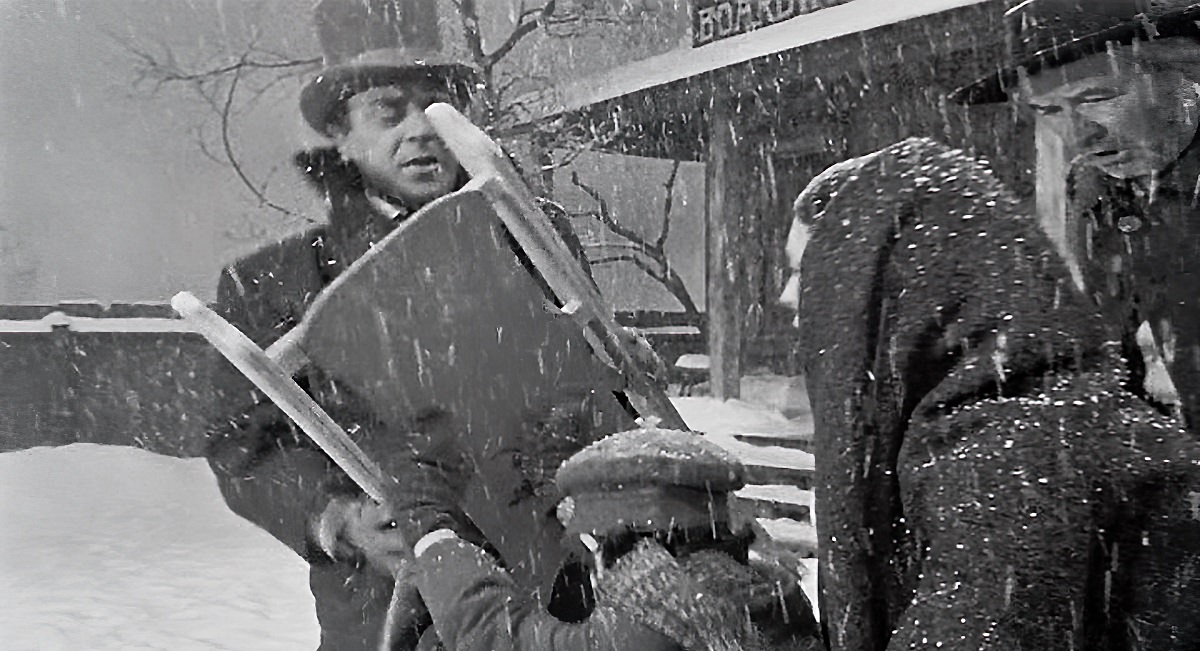
At a time when Hollywood was still relatively young, “Citizen Kane” pushed the boundaries of storytelling, cinematography, and character development. And it did this, in no small part, by using the Rosebud Sled as a focal point, cementing its significance in a manner that transcended mere prop usage. Here was an object that was not only crucial to the story but also to the nuanced understanding of a deeply flawed yet intensely relatable individual. It’s a storytelling masterpiece that set the bar high for future generations of filmmakers, showing how a simple object can be elevated to become the beating heart of a film.
Why It’s Iconic: The Multifaceted Mirror Reflecting the Human Psyche
While its role as a storytelling device is unparalleled, what truly marks the Rosebud Sled as iconic is its function as a haunting visual metaphor—a symbol soaked in the complexities of human emotion, longing, and inescapable regret. Unlike other props that may symbolize a single concept or emotion, Rosebud serves as a multi-layered emblem. On one hand, it’s a gateway to Kane’s past, a silent witness to a moment in time when happiness was uncomplicated and unburdened by the weight of ambition or the relentless passage of time. On the other, it’s an unsolvable puzzle that challenges audiences to grapple with the often contradictory facets of human nature.
The true brilliance of Rosebud lies in its ability to provoke thought and elicit a myriad of interpretations. For some, it might signify the one true regret of a man who gained the world but lost his soul. For others, it stands as a cruel reminder of the impermanence of happiness, the elusive nature of contentment, and the hollow emptiness that often accompanies monumental success. What’s unequivocal is that the sled is a mirror, reflecting not just the complexities of Kane’s character but also the shared human experiences of yearning for simpler times and the youthful innocence that adulthood corrodes.
The enigma of Rosebud also extends beyond the film into the larger cultural discussion about ambition, life’s purpose, and the cost of relentless pursuit of success. This prop is regularly cited in scholarly articles, dissected in film studies classes, and referenced in countless other forms of media. It is not merely a piece of painted wood; it’s an everlasting subject of debate and analysis that challenges us to consider what our own “Rosebuds” might be.
Therefore, Rosebud isn’t just iconic; it’s almost mythic. It navigates the vast and intricate corridors of the human psyche, asking questions that are as relevant today as they were over eight decades ago. Its haunting presence has turned it into an eternal symbol of both personal and universal significance, making it one of the most intellectually engaging and emotionally resonant props ever to grace the silver screen. And so, Rosebud remains imprinted in our collective cinematic memory, an enduring icon that continues to invite introspection and ignite imagination.
#8: The Ark of the Covenant Movie Prop – “Raiders of the Lost Ark”
When it comes to artifacts that have ignited the imaginations of audiences, few can hold a candle to the Ark of the Covenant as presented in Steven Spielberg’s 1981 seminal adventure classic, “Raiders of the Lost Ark.” Seamlessly weaving biblical mythology with Hollywood’s grandeur, the Ark is the cornerstone that defines the entire pulse-pounding quest of the intrepid archaeologist Indiana Jones, portrayed by Harrison Ford. Rooted deeply in religious texts as the chest containing the Ten Commandments, the Ark in the film takes on dimensions far exceeding its biblical connotations. It’s not merely an object of reverence but a cinematic vessel teeming with power, danger, and boundless mystery.
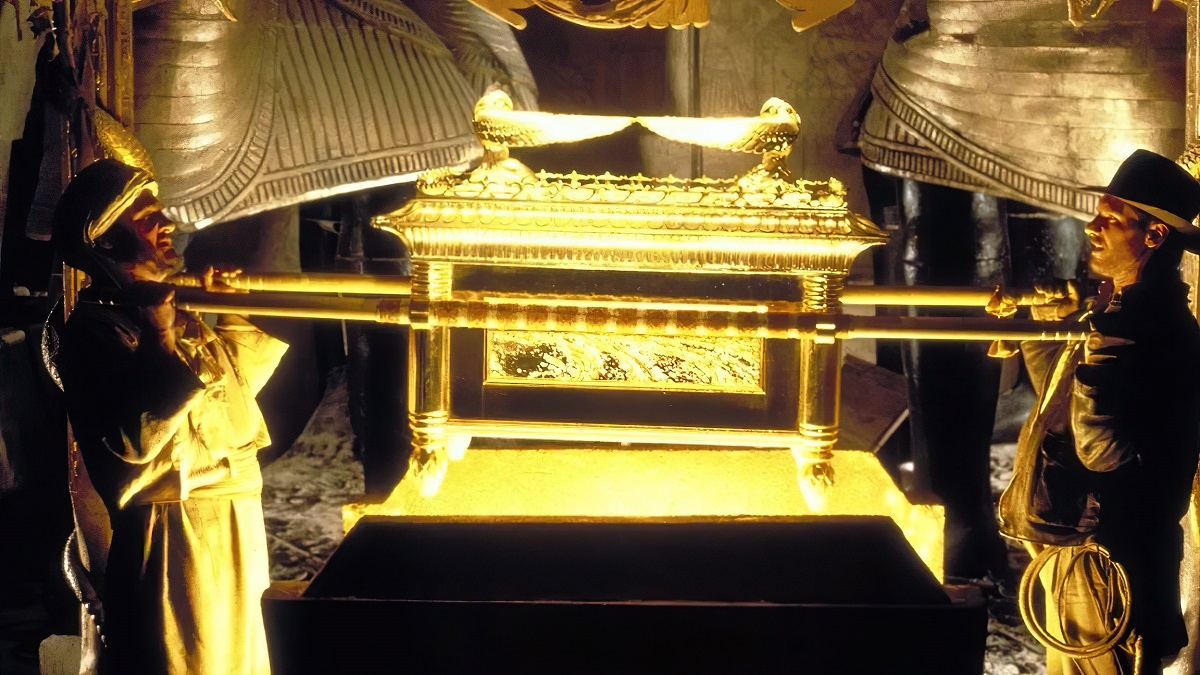
In the inaugural chapter of what would become a legendary franchise, Spielberg and George Lucas cemented Indiana Jones as a pop-culture icon, and the Ark of the Covenant was indispensable in achieving that feat. This masterfully crafted cinematic relic serves as the axis around which the movie’s action, suspense, and thematic depth rotate. Its function is not just as a McGuffin that drives the plot forward but as a talismanic object that personifies the very ethos of adventure. Amidst whizzing bullets, menacing villains, and exotic locales, the Ark holds its own as a character, radiating a charisma that is as captivating as it is terrifying. It’s not just the prize at the end of Indiana Jones’ quest; it’s the embodiment of the stakes, the danger, and the lore that make the journey meaningful.
Why It’s Iconic: The Quintessence of Adventure and the Endless Pursuit of Knowledge
One of the many reasons the Ark of the Covenant stands tall among the pantheon of movie props is because it’s emblematic of the adventure genre itself—brimming with enigma, fraught with peril, and deeply anchored in the annals of human history and imagination. But it’s not just any adventure; it’s an adventure that brushes up against the divine and the supernatural, encapsulating humanity’s relentless pursuit of knowledge and understanding, even when that pursuit skirts the boundaries of the unknown and the dangerous.
The Ark in the film serves as a poignant reminder of the duality of discovery: it represents not just the thrill of the quest but the dangers that lurk when humanity courts powers beyond its understanding. It stands as a symbol of the limits of human intellect and the perils of hubris, qualities that transform it from a mere object into a storytelling powerhouse. Its dramatic unveiling at the end of the film isn’t just a climax; it’s a reckoning—a vivid, horrifying testament to the unpredictable consequences of meddling with forces that transcend human comprehension.
Beyond its role in the film, the Ark of the Covenant has reverberated throughout popular culture, inspiring a slew of adventure tales, becoming a staple in discussions about blending mythology with fiction, and even sparking conversations about the ethical dimensions of archaeology. You can find its replicas in fan conventions, its analyses in scholarly articles, and its influence in various adventure narratives that followed. It transcends its status as a prop to become a symbol of humanity’s collective fascination with the mysterious and the unknown. Its iconic status is bolstered by its multifaceted representation of adventure: the allure, the danger, and the moral quandaries that accompany the journey toward discovery.
The Ark of the Covenant is not just a relic sought by a charming archaeologist; it’s a complex, multi-layered artifact that pushes the boundaries of storytelling, character development, and thematic depth. Its allure is universal, capturing the essence of humanity’s quest for knowledge, the thrill of discovery, and the ethical conundrums that such pursuits often entail. Its aura permeates beyond the film, making it one of the most enduring, captivating, and intellectually stimulating props ever to grace the cinematic world. And that is why the Ark of the Covenant reigns supreme as an unassailable icon of cinematic adventure, inviting us to ponder the tantalizing and terrifying possibilities that lie in the pursuit of the great unknown.
#9: The Holy Grail Movie Prop – “Indiana Jones and the Last Crusade”
In the annals of iconic movie props, few can rival the sheer grandiosity and thematic weight of the Holy Grail in “Indiana Jones and the Last Crusade,” the 1989 cinematic treasure directed by Steven Spielberg. Venturing beyond the sensational excitement of high-stakes archaeology, the film taps into one of the most alluring mysteries in both Christian theology and Arthurian legend: the Holy Grail, the elusive cup said to have caught the blood of Christ at the Crucifixion. What separates this prop from others in the genre is its extraordinary capacity to be far more than an object of quest; it’s a spiritual and moral lodestar in a tale of action, courage, and ethical dilemmas.
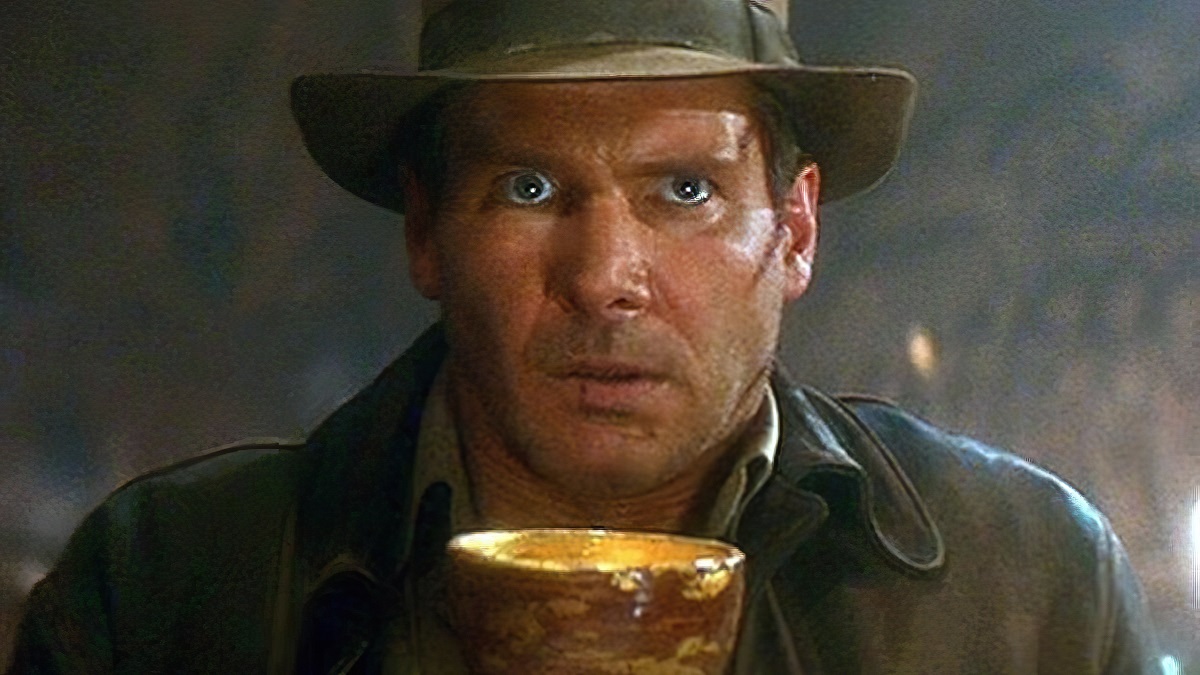
To say that the Holy Grail is pivotal to this third installment of Indiana Jones’ adventures would be a gross understatement. It’s not just a chalice of divine importance, but rather an ultimate narrative goal, drenched in religious, historical, and ethical complexity. Spielberg and George Lucas present this mythical cup not just as a golden artifact, but as a symbol of transcendence that connects generations, posing moral challenges that go beyond mere mortal jeopardy. It becomes the driving force behind Indy’s quest, a touchstone for his relationship with his father, Henry Jones Sr., and a moral litmus test that promises immortality and ultimate knowledge—yet at a potentially devastating cost.
Why It’s Iconic: A Multi-dimensional Moral Compass and a Reflective Mirror of Inner Virtue
The Holy Grail is iconic not just for its historical and religious connotations, but for the profound ways in which it tests the morality and inner fabric of the characters who dare to seek it. While many props serve to embellish the visual or thematic elements of a movie, the Grail goes several steps further: it becomes a judge, an examiner of souls, forcing seekers to confront not just external obstacles but internal landscapes of their own making.
As the adventurers navigate through deadly trials to reach the sanctified relic, what becomes increasingly clear is that the Grail is not just a test of skill and wit but of character. It stands as an object of intense ethical scrutiny, compelling the seeker to confront their deepest moral convictions and ethical boundaries. It asks not just if you are brave enough to seize it, but whether you are worthy of its promise. And herein lies its true power: it elevates itself from being a mere plot device to a litmus test for virtue, wisdom, and ethical integrity. In the context of the film, the Grail serves as a narrative pivot around which key character arcs, especially those of Indiana and his father, revolve. It is their pursuit of the Grail that exposes their vulnerabilities, fuels their redemption, and ultimately, transforms them.
The Holy Grail’s transcendence of its inanimate form also impacts the real world, sparking dialogue about the intersection of faith and history, the ethics of treasure hunting, and the complex relationship between spirituality and morality. Its presence in the film has inspired books, debates, and even real-world explorations, drawing both religious scholars and adventurers into its magnetic aura of divine mystery. It continues to serve as a subject of critical study, dissected in theological treatises, adventure literature, and ethics discourse.
In sum, the Holy Grail is not merely a prop; it is an evocative symbol and an ethical dilemma rolled into one. It challenges both characters and audiences to ponder the complexities of morality, the allure of immortality, and the often-dangerous intersection of faith and desire. Its iconic status emanates not just from its golden allure or religious significance, but from its multifaceted role as a moral compass, a relational catalyst, and a timeless symbol of humanity’s eternal quest for the divine and the enigmatic. This elevates the Holy Grail from a mere cinematic object to a mythic element of cultural storytelling, setting it apart as one of the most intriguing, multi-dimensional, and captivating props ever to grace the silver screen.
#10: The Inception Top Movie Prop – “Inception”
When Christopher Nolan released the groundbreaking, genre-defying thriller “Inception” in 2010, few could have predicted the ripple effect it would have across the realms of cinematic storytelling, philosophy, and even metaphysics. At the eye of this intellectual and imaginative storm is a seemingly innocuous item: a small, metal spinning top. While it may lack the religious import of the Holy Grail or the operatic gravitas of a lightsaber, the Inception top has burrowed its way into our collective cultural consciousness as one of the most enigmatic and talked-about movie props of all time.
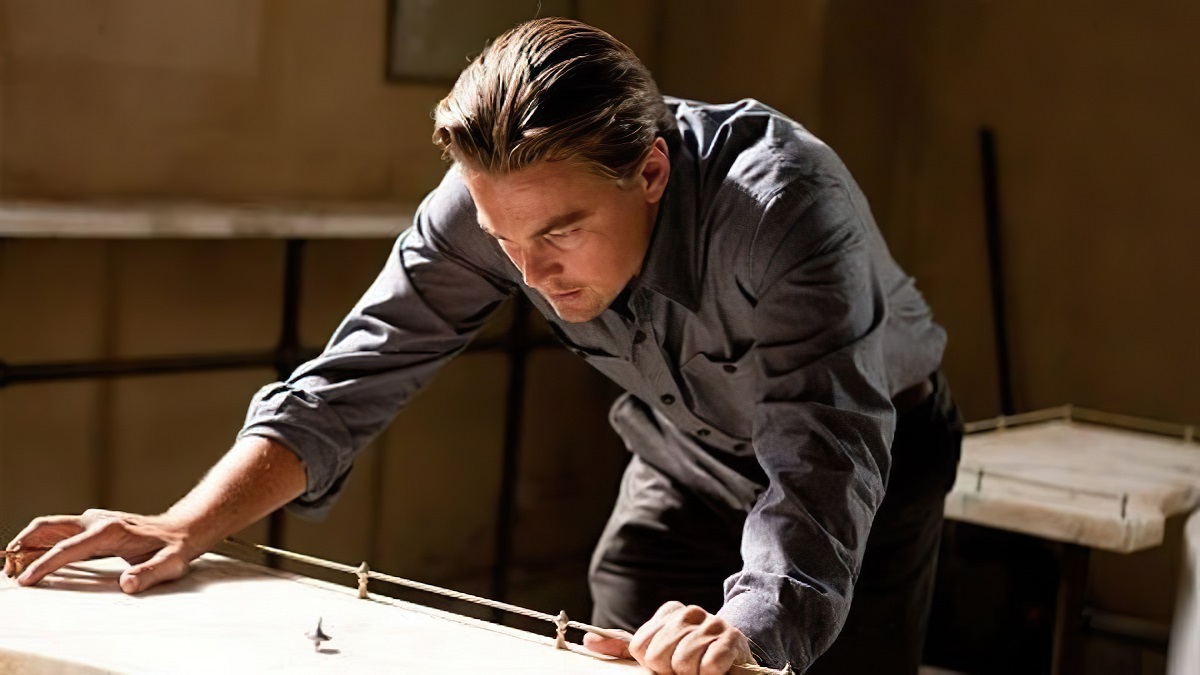
Unlike many iconic props that serve as coveted treasures or powerful weapons, the Inception top has a far more cerebral role. It is the quintessential tool of reality-testing within the labyrinthine layers of dreams and shared consciousness explored in the film. It’s more than just a device; it’s the fulcrum upon which the film’s thematic complexity and existential ponderings balance. Within the layered dreamworlds constructed by Dom Cobb (Leonardo DiCaprio) and his team, the top is the only constant that can anchor one’s perception of reality. And yet, even as it serves as a grounding point, it also launches viewers into a swirling vortex of interpretations and debates, cementing its place not only as an iconic movie prop but also as a modern philosophical enigma.
Why It’s Iconic: A Philosophical Totem that Keeps Audiences Spinning
As a physical manifestation of the film’s intricate narrative machinations, the spinning top goes beyond its metallic simplicity to symbolize a multitude of themes: the fragility of reality, the complexity of consciousness, and the illusory nature of perception, to name just a few. Unlike props that are designed to dazzle the eye or inspire awe, the Inception top captivates the mind. It’s a psychological puzzle encapsulated in metal, challenging the viewer to question not just the narrative unfolding on screen, but the very nature of existence and subjective experience.
Its true genius lies in its ambiguity. As the top spins in the film’s final moments, it leaves viewers suspended in a state of delicious, maddening uncertainty. Did it wobble? Will it fall? The questions are not just about the top but about the fabric of reality itself. This singular object becomes a prism through which the film’s complex themes are refracted, echoing long after the credits roll and spawning countless debates, analyses, and re-examinations. Its impact extends into academic discussions, inspiring essays and studies that dissect its existential and metaphysical implications. One could argue that no other movie prop has instigated such a widespread intellectual discourse, permeating discussions from casual film forums to scholarly articles.
Furthermore, the top has transcended the boundaries of its cinematic origin to become a cultural symbol of uncertainty and the quest for truth. It appears in memes, inspires artworks, and even gets replicated as merchandise. For a generation grappling with questions of reality in an increasingly digital and virtual landscape, the Inception top serves as a metaphorical anchor as well as a challenge to scrutinize what we accept as real.
In summary, the Inception top may be small in size, but its symbolic and cultural weight is colossal. It’s not merely a prop but a vortex of interpretation, a spinning enigma that invites us to delve into the complexities of consciousness, perception, and reality. It challenges us to question, to debate, and to ponder the unfathomable depths of human experience. And perhaps most brilliantly, it embodies the spirit of “Inception” itself—a film that not only entertains but also provokes, disrupts, and lingers in our collective imagination. This humble spinning top thus spins eternally at the intersection of cinema and philosophy, making it an iconic artifact for the ages.
Movie props are not mere objects; they are essential elements in storytelling, embodying themes, characters, and entire worlds. These top 10 movie props have transcended their films to become cultural landmarks, each telling its own story of cinematic history and collective imagination.
Learn more about 3D Movie Props
See our all-inclusive 268 Movie Props. Learn more about our movie props at Giant Props or 3D Props.
Contact us today to learn more about our services and how we can help you achieve your goals.
